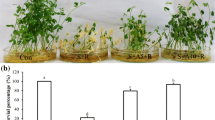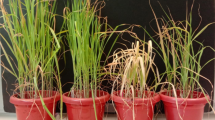Abstract
Azolla microphylla plants exposed directly to NaCl (13 dsm-1) did not survive the salinity treatment beyond a period of one day, whereas plants exposed directly to 4 and 9 dsm-1 NaCl were able to grow and produce biomass. However, plants pre-exposed to NaCl (2 dsm-1) for 7 days on subsequent exposure to 13 dsm-1 NaCl were able to grow and produce biomass although at a slow rate and are hereinafter designated as pre-exposed plants. The pre-exposed and directly exposed plants distinctly differed in their response to salt in terms of lipid peroxidation, proline accumulation, activity of antioxidant enzymes, such as SOD, APX, and CAT, and Na+/K+ ratio. Efficient modulation of antioxidant enzymes coupled with regulation of ion transport play an important role in the induction of salt tolerance. Results show that it is possible to induce salt adaptation in A. microphylla by pre-exposing them to low concentrations of NaCl.
Similar content being viewed by others
References
Acar O, Turkan I, Ozdemir F (2001) Superoxide dismutase and peroxidase activities in drought sensitive and resistant barley (Hordeum vulgare L.) varieties. Acta Physiol Plant 3:351–356
Aebi H (1984) Catalase in vitro. Meth Enzymol 105:121–126
Alia Bhalu B, Mohanty P, Matysik J (2000) Effect of proline on the production of singlet oxygen. Amino Acids 21:195–200
Amzallag GN, Lerner HR, Poljakoff-Mayber A (1990) Induction of increased salt tolerance in Sorghum bicolor by NaCl pretreatment. J Exp Bot 41:29–34
Ashraf M, Harris PJC (2004) Potential biochemical indicators of salinity tolerance in plants. Plant Sci 166:3–16
Atreya A, Vartak V, Bhargava S (2009) Salt priming improves tolerance to dessication stress and to extreme salt stress in Bruguiera cylindrica. Int J Int Biol 6(2):68–73
Bates LS, Waldren RP, Tear ID (1973) Rapid determination of free proline for water stress studies. Plant Soil 39:205–207
Bor M, Ozdemir F, Turkan I (2003) The effect of salt stress on lipid peroxidation and antioxidants in leaves of sugar beet Beta vulgaris L and wild beet Beta maritiname L. Plant Sci 164:77–84
Bradford MM (1976) A rapid and sensitive method for the quantification of microgram quantities of protein utilizing the principle of protein dye binding. Anal Biochem 72:248–254
Cheeseman JM (1988) Mechanisms of salinity tolerance in plants. Plant Physiol 87:547–550
Colmer TD, Fan TWM, Higashi RH, Lauchli A (1996) Interactive effects of Ca2+ and NaCl salinity on the ionic relations and proline accumulation in the primary root tip of Sorghum bicolor. Physiol Plant 97:421–424
Cramer GR, Alberieo GJ, Schmidt C (1994) Salt tolerance is not associated with the sodium accumulation of two maize hybrids. Aust J Plant Physiol 21:675–692
Daneshmond F, Arvin JM, Kalantari KM (2010) Physiological response to NaCI stress in three wild species of Potato in vitro. Acta Physiol Plant 32:91–101
Dionisio-Sese ML, Tobita S (1998) Antioxidant responses of rice seedlings to salinity stress. Plant Sci 135:1–9
Ebert G, Eberle G, Ali-Dinar H, Ludders P (2002) Ameliorating effects of Ca (NO3)2 on growth, mineral uptake and photosynthesis of NaCl-stressed guava seedlings (Psidium guajava L.). Sci Hortic 93:125–135
Espinase CR, Watanabe I (1976) Potential of nitrogen fixing Azolla-Anabena complex as fertililizer in paddy soil. IRRI Saturday Seminar, 14th August
Ghassemi F, Jakeman AJ, Nix HA (1995) Salinization of land and water resources. CAB International, Wallingford, UK
Greenway H, Munns R (1980) Mechanism of salt tolerance in non-halophytes. Annu Rev Plant Physiol 31:149–159
Haller WT, Sutton DL, Barlowe WC (1974) Effects of salinity on the growth of several aquatic macrophytes. Ecology 55:891–894
Heath RL, Packer L (1968) Photoperoxidation in isolated chloroplasts: 1. Kinetics and stoichiometry of fatty acid peroxidation. Arch Biochem Biophys 125:189–198
Hernandez JA, Campillo A, Jimenez A, Alarcon JJ (1999) Responses of antioxidant systems and leaf water relations to NaCl stress in pea plants. New Phytol 141:241–251
Hernandez JA, Corpas FJ, Gomez M, del Rio LA, Sevilla F (2010) Salt induced stress mediated by activated oxygen species in pea leaf mitochondria. Physiol Plant 89(1):103–110
Hossain Z, Mandal AKA, Shukla R, Datta SK (2004) NaCl- stress its chromotoxic effects and antioxidant behavior in roots of Chrysanthemum morifolium Ramat. Plant Sci 166:215–220
Khelil A, Menu T, Ricard B (2007) Adaptive response to salt involving carbohydrate metabolism in leaves of a salt sensitive tomato cultivar. Plant Physiol Biochem 45:551–559
Lumpkin TA (1987) Environment requirement for successful Azolla growth. In: International Rice Research Institute, Azolla-utilization. Proceedings of the Workshop of Azolla use. IRRI, Los Banos Philippines, pp. 89-97
Masood A, Shah NA, Zeeshan M, Abraham G (2006) Differential response of antioxidant enzymes to salinity stress in two varieties of Azolla (Azolla pinnata and Azolla filiculoides). Environ Exp Bot 58:216–22
Matysik J, Alia Bhalu B, Mohanty P (2002) Molecular mechanisms of quenching of reactive oxygen species by proline under stress in plants. Curr Sci 82:525–532
Munns R, Hare RA, James RA, Rebetzke GJ (2000) Genetic variation for improving the salt tolerance of durum wheat. Aust J Agric Res 51:69–74
Nakano Y, Asada K (1984) Hydrogen peroxide is scavenged by ascorbate specific peroxidase in spinach chloroplasts. Plant Cell Physiol 22:867–880
Navari-Izzo F, Quartacci MF, Sgherri CLM (1996) Superoxide generation in relation to dehydration and rehydration. Biochem Soc Trans 24:447–451
Pantalone VR, Kenworhty WJ, Slaughter LH, James BR (1998) Chloride resistance in soybean and perennial glycine accessions. Euphytica 97:235–239
Peters GA (1978) Blue–green algae and algal associations. Bioscience 28:580
Rai AK, Rai V (1999) Growth behavior of Azolla pinnata at various salinity levels and induction of high salt tolerance. Plant Soil 206:79–84
Rai V, Sharma NK, Rai AK (2006) Growth and cellular ion content of a salt-sensitive symbiotic system Azolla pinnata–Anabaena azollae under NaCl stress. J Plant Physiol 163:937–944
Rontain D, Basset G, Hanson AD (2002) Metabolic engineering of osmoprotectant accumulation in plants. Met Eng 4:49–56
Rout NP, Shaw BP (2001) Salt tolerance in aquatic macrophytes: possible involvement of the antioxidative enzymes. Plant Sci 160:415–423
Ruffino AMC, Rosa M, Hilal M, Gonzalez JA, Fernando EP (2010) The role of cotyledon metabolism in the establishment of Quinoa (Chenopodium quinoa) seedlings growing under salinity. Plant Soil 326(1–2):213–224
Scandalios JG (1993) Oxygen stress and superoxide dismutase. Plant Physiol 101:7–12
Shalata A, Tal M (1998) The effect of salt stress on lipid peroxidation and antioxidants in the cultivated tomato and its wild salt tolerance relative Lycopersicon pennellii. Physiol Plant 104:169–174
Shalata A, Mittova M, Volokita M, Guy M, Tal M (2001) Response of the cultivated tomato and its wild salt tolerant relative Lycopersicon pennellii to salt-dependant oxidative stress: the root antioxidative system. Physiol Plant 112:487–494
Sreenivasulu N, Grimm B, Wobus U, Weschke W (2000) Differential response of antioxidant compounds to salinity stress in salt tolerant and salt-sensitive seedlings of foxtail millet (Setaria italica). Physiol Plant 109:435–442
Stewart RRC, Bewley JD (1980) Lipid peroxidation associated with accelerated ageing of soyabean axes. Plant Physiol 65:245–248
Sudhakar C, Lakshmi A, Giridara Kumar S (2001) Changes in antioxidant enzyme efficacy in two high yielding genotypes of mulberry (Morus alba L.) under NaCl salinity. Plant Sci 161:613–619
Tester M, Davenport R (2003) Na+ tolerance and transport in higher plants. Ann Bot 9:503–527
Umezava T, Shimizu K, Kato M, Ueda T (2000) Enhancement of salt tolerance in soybean with NaCl pretreatment. Physiol Plant 110:59–63
Wagner GM (1997) Azolla: a review of its biology and utilization. Bot Rev 63:1–21
Watanabe I, Espianase CR, Berja NS, Alimango BA (1977) Utilization of the Azolla–Anabaena complex as a nitrogen fertilizer for rice. Inl Rice Res Institute Paper Series 11:1–15
Yazici I, Turkan F, Sekmen AH, Demiral T (2007) Salinity tolerance of pursulane (Portulaca oleracea L.) is achieved by enhanced antioxidative system, lower levels of lipid peroxidation and proline accumulation. Environ Exp Bot 61(1):49–57
Zhu JK (2001) Plant salt tolerance. Trends Plant Sci 6:66–71
Zhu JK (2003) Regulation of ion homeostasis under salt stress. Curr Opin Plant Biol 6:441–445
Acknowledgements
Financial support from Indian Council for Agricultural Research, New Delhi, India, is gratefully acknowledged. Thanks are due to the Director and Joint Director (Research) and Head, Division of Microbiology, Indian Agricultural Research Institute, New Delhi, for providing facilities and encouragement.
Conflict of interest
The authors declare that they have no conflict of interest.
Author information
Authors and Affiliations
Corresponding author
Additional information
Handling Editor: Bumi Nath
Rights and permissions
About this article
Cite this article
Abraham, G., Dhar, D.W. Induction of salt tolerance in Azolla microphylla Kaulf through modulation of antioxidant enzymes and ion transport. Protoplasma 245, 105–111 (2010). https://doi.org/10.1007/s00709-010-0147-3
Received:
Accepted:
Published:
Issue Date:
DOI: https://doi.org/10.1007/s00709-010-0147-3




